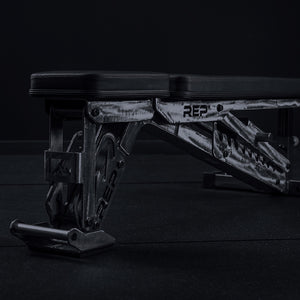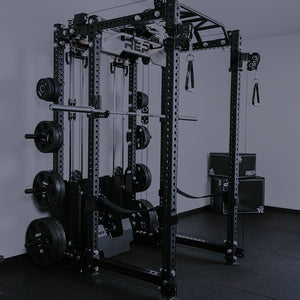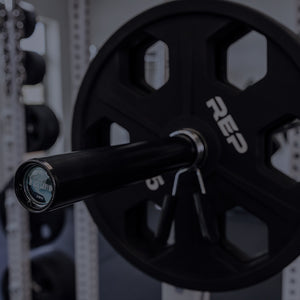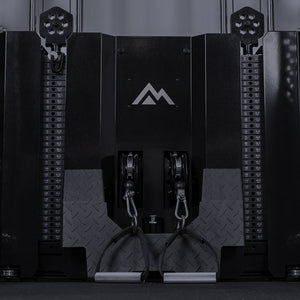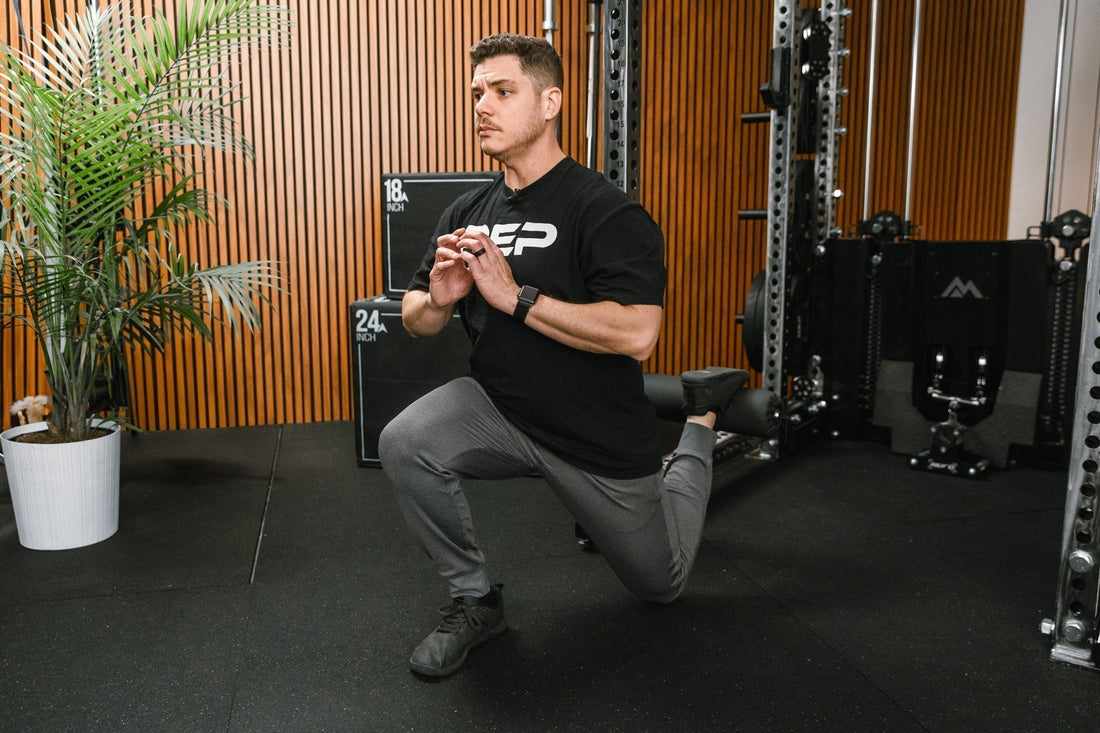
Drop it like it's squatttt.
The Bulgarian split squat, is a variation of the split squat with your back foot propped up on a weight bench (also known as the rear-foot elevated split squat). It offers everything you need to build quad muscle, but here’s the catch: it’s tough. You’ll need solid balance to perform the squat with your back leg elevated, and the deep quad stretch results in a muscle burn that may make it the most avoided exercise.
To learn the right way to execute the Bulgarian split squat, we interviewed Noah Tenenbaum, REP Product Analyst, and a certified strength & conditioning specialist with a master’s degree in applied physiology and kinesiology (fancy).
How to Do the Bulgarian Split Squat
If you’ve never tried the Bulgarian split squat (also called the rear-foot elevated split squat), it may feel a bit awkward at first. The movement challenges your balance and stability while placing significant tension on your quads and glutes. Before adding weight, practice the form to get a proper feel for the movement.
-
Get the Right Equipment: For the Bulgarian Split Squat, you’ll need an elevated surface about 12 inches tall—think weight bench, plyo box, leg curl attachment, or a BSS pad, which some gyms have. This guide mainly covers the dumbbell Bulgarian split squat, so be sure to grab a good set of dumbbells. (We suggest lifting straps to prevent grip from being a limiting factor).
-
Find Your Stance: Sit on the bench, dumbbells resting on your thighs. Extend your right leg so it's straight, and your heel digs into the floor. Stand up so your right foot is flat on the floor, placing the dumbbells next to your front foot. Position your back foot on the bench, lace down, pressing firmly to avoid side-to-side shifting. Squat down, grab your dumbbells, and stand back up.
-
Squat Down: Focus on a fixed spot on the wall to help balance. Slowly squat down, driving your back knee toward the floor until it taps. Keep your torso steady and controlled throughout the movement.
-
Explode Up: Don’t bang your knee on the floor—hover about an inch above the surface before driving up through your front foot to stand back up. For maximum muscle growth, use a 3-1-1-0 tempo: three seconds down, one-second pause at the bottom, one second up, and no pause at the top.
Avoid These Bulgarian Split Squat Mistakes
To get the most out of your Bulgarian split squats, you need to pay attention to the details. Here are four common mistakes people make when executing the BSS and simple tweaks you can make to avoid them.
Don’t: Lean Too Far Forward
Tenenbaum says your torso angle should roughly mimic the angle of your front shin, which is roughly a 60-degree lean. To keep it simple, don’t overcompensate your lean in either direction. Find a torso position that feels comfortable and maintain it throughout the set. You should feel even tension in your quads and glutes during each rep.
Don’t: Drive Through Your Back Leg
Think of your back leg as a tripod, stabilizing your body while your front leg works. If you push through your back foot, you’ll take tension away from your quad. The fix is simple: Start with bodyweight sets to get the feel of the movement, then reduce the weight during working sets. It's better to target your front thigh with less weight than rely on your back leg to lift more.
Don’t: Place the Toes of Your Back Foot On the Bench
It may feel natural to push your back toes onto the bench, but this position is unstable and increases the risk of ankle injury. Instead, place the entire top of your back foot (think shoelaces) on the bench for better stability and balance during the BSS.
Don’t: Let Your Front Knee Sway
The age-old myth of “your knees shouldn't go over your toes” during the squat has been thoroughly debunked. This 2023 study asserts that anterior knee displacement (aka forward movement of the knee) isn’t only safe for healthy individuals but “is considered a normal and a required part of the squat movement…that should be encouraged.” All this to say, it’s OK for your knees to pass your toes, but avoid letting the knee cave in or fall outward, which can strain your tendons and ligaments.
Muscles Worked
Your quads and glutes bear the brunt of the load during sets of the Bulgarian split squat, but the unstable nature of the exercise also brings your core and quads into play. Here’s a full list of the Bulgarian split squat muscles worked:
Primary Muscles
-
Quads: Your quadriceps—rectus femoris, vastus lateralis, vastus intermedius, and vastus medialis—are responsible for leg flexion (kicking it forward) and knee stabilization. Whenever your knee bends, whether you’re squatting, jumping, or climbing stairs, your quads are engaged.
-
Glutes: The gluteus maximus, gluteus medius, and gluteus minimus are primarily responsible for hip rotation and extension. During the Bulgarian split squat, they’re most active during the top half of the movement as you fully lock out your hips.
-
Core: The core isn’t just your abs. It’s a group of muscles, including the rectus abdominis, obliques, glutes, and spinal erectors, that stabilize your spine and trunk. Your core is engaged in most free-weight exercises, but during the BSS, they work hard to keep you balanced on your front leg and prevent excessive torso rotation.
Secondary Muscles
-
Calves
-
Hamstrings
-
Adductors (inner thighs)

Benefits of the Bulgarian Split Squat
They’re challenging, but Bulgarian split squats are worth subbing into your routine. Here are four benefits to performing this powerful leg-day addition.
Less Injury Risk Compared to Squats
Supporting a barbell loaded with hundreds of pounds on your back compresses the intervertebral discs in your spine. That sounds scary, but it’s not really a problem as long as you execute the back squat with good form. Still, performing Bulgarian split squats with dumbbells eliminates spinal compression. If you have a pre-existing back injury (please consult a doctor before making a change to your exercise routine if you do), then swapping out back-loaded squats for front-loaded variations reduces your risk of back injury.
Tennenbaum also notes that it’s much easier to bail when failing a heavy BSS than failing a heavy back squat: “Holding weights at your side while performing the exercise allows the lifter to drop them safely if they feel at risk for injury.”
You’ll Work on Stability
Your balance will be challenged during the BSS. “If you lose postural control, you will sway forward, and likely need to take your foot off the elevated surface,” Tenenbaum explains. If you’ve ever wondered why the BSS feels less stable than a standard split squat or lunge, it’s likely because your front leg is supporting 85% of the load during the BSS, according to a study published in the Strength and Conditioning Journal, which is 10% more than the lunge and split squat.
As you perform the BSS, your supporting muscles, like the adductors (of the inner thighs), gluteus medius, and your core musculature, work harder than they do during a traditional squat. These muscles won’t grow, but they will become stronger and better equipped to keep you stable. Confidence on one leg carries over to sports and other lifts, like walking lunges and single-leg squats (see below). If your primary goal is to improve your balance, then try doing the BSS with lighter weight and for more reps (12+).
More Work In One Exercise
Because the BSS is a single-leg movement, you’re doing double the work compared to bilateral leg exercises like the back squat or leg press. If your program calls for eight reps of the BSS, you need to do eight reps per leg for 16 reps.
“Your body is still holding the weights and producing force for 16 reps,” says Tenenbaum. “The demand placed on the body for this loading is pretty tiring per set, and you may need to rest a little more than you would think compared to the needed weight for this effect in a barbell back squat.”
Better Hip Mobility
The bottom of the Bulgarian split squat mimics what’s called a couch stretch — a static hip stretch that’s done from a half-kneeling position with your back leg flexed against a wall or bench. So you can think of each rep of the BSS as a weighted couch stretch. Mobility is, after all, defined by your strength in the end range of motion. Since the BSS is strengthening your hips in their most stretched state, you are enhancing the mobility of those muscles in addition to strengthening and growing your quads.
Bulgarian Split Squat Regression and Progressions
You shouldn’t expect to nail the BSS out the gate. It requires coordination, balance, strength, and grit to power through. Below, we provide two regressions and progressions you can (and probably should) master before and after doing the BSS — all of which suggested by Tenenbaum.
Regression: Bodyweight Squat
Though they look different, the Bulgarian split squat and standard squat are similar in that they both require you to extend and flex your knees and hips. If you’re new to strength training (or have never done a split squat), the traditional both-feet-on-the-ground squat will strengthen the same muscles as the BSS without the balance requirements. Do the bodyweight squat for a few weeks and then move onto the goblet squat to further challenge and strengthen your muscles.
How to Do it:
-
Stand with your feet shoulder-width apart, toes slightly turned out.
-
Keeping your chest up and your core engaged, lower your body by pushing your hips back and bending your knees, like you're sitting in a chair.
-
Go as low as you can without your back rounding. It’s ok if your knees track over your toes.
-
Push through your heels to return to standing, extending your hips and knees at the top.
Regression: Split Squat
With your back foot planted on the ground, the split squat is a more stable version of the Bulgarian Split Squat. You'll target your quads and glutes through a slightly reduced range of motion while building the balance and coordination needed to nail the BSS.
How to Do it:
-
Start with your feet hip-width apart, standing tall.
-
Take a step forward with one leg, ensuring your front foot is flat on the floor and your back leg is straight.
-
Lower your body until your back knee just touches the floor and the knee of your front leg is over your toes. Both legs should be bent at roughly 90 degrees.
-
Push through your front foot to return to standing, keeping your torso upright and core engaged.
Progression: Skater Squat
The skater squat is essentially a Bulgarian split squat without the support of your back leg. With your back foot floating behind you, unsupported, your front leg does all the work. This progression focuses on building balance and stability. Use lighter weight for higher reps to improve control and muscular endurance.
How to Do it:
-
Stand with your feet hip-width apart, holding a light dumbbell in each hand.
-
Shift your weight to one leg, slightly bending your knee, and extend your opposite leg behind you.
-
Lower your body as far as you can while keeping your chest upright and maintaining control of your balance.
-
Tap your back knee to one or two bumper plates placed just below the knee of your back leg. Push through your heel to return to standing.
Progression: Single-Leg Squat
Similar to the skater squat, the single-leg squat involves performing a squat with one foot off the ground. The difference is that this Bulgarian split squat alternative resembles a true squat pattern, with your floating leg set in front of you and your glutes reaching back to touch a plyo box. It’s a great progression for developing unilateral strength and balance.
How to Do it:
-
Stand in front of a plyo box or elevated surface, keeping one leg lifted off the ground, holding a light weight plate or dumbbell (like five pounds) in each hand for counterbalance.
-
Slowly lower your hips back and down, allowing your knees to track over your toes.
-
As you descend into the squat, extend your floating leg forward and aim to touch your glutes lightly on the box (without sitting).
-
Push through your standing heel to return to the starting position. To make the move even more challenging, aim to lower the box over time.
Bulgarian Split Squat Variations
There are plenty of other single-leg focused exercises you can rotate into your next program. Stick to one variation of the BSS for about four weeks before programming another one, so you have time to acclimate to it. Once you’re ready to switch things up, try one of these three variations.
Barbell Split Squat
Instead of holding dumbbells, you’ll stabilize a loaded barbell across your upper back. This allows stronger lifters to load far more weight than they could with dumbbells, making the barbell BSS an excellent option for those looking to increase strength. Additionally, the barbell version offers more stability as your hands are locked in place during the set.
How to Do It:
-
Set a barbell on the j-hooks of a power (or squat) rack at about chest height and load it with your desired weight.
-
Step under the bar, positioning it across your upper back (not on your neck). Grip the bar with both hands, keeping your elbows slightly bent and pointed toward the floor.
-
Unrack the barbell and take a step out of the rack. Set one foot back into a split squat position on a weight bench or BSS stand, making sure your front knee is set over your toes.
-
Lower your back knee toward the floor, keeping your torso upright and front knee tracking over your toes.
-
Push through your front heel to return to the starting position. Repeat for the desired reps, then switch legs.
Front Foot-Elevated Split Squat
By elevating your front foot, you increase the range of motion of your hips, placing a greater emphasis on your glutes, and your quads. If you stand on a surface taller than six inches, your front thigh will spend more time in the bottom three-quarters of the range of motion, creating more muscle tension.
How to Do It:
-
Set a dumbbell on either side of your body. Then, place one foot on two 45-pound bumper plates stacked on each other set in front of you. Plant your other foot on the floor behind you in a split squat stance.
-
Squat down to pick up the dumbbells (we suggest using straps).
-
Take a deep breath into your stomach and tense it. Now lower your back knee to the floor, keeping your chest up. Make sure your front knee tracks over your toes.
-
Push through your front foot to return to the standing position.
Walking Lunge
The walking lunge mirrors the split squat but adds a dynamic element. As you step forward with each rep, you engage more stabilizing muscles, improving coordination and balance while hitting the quads and glutes.
How to Do It:
-
Stand upright with your feet hip-width apart and a dumbbell in each hand.
-
Take a big step forward with one leg, squatting down until both knees are bent at about 90 degrees. You can tap your back knee on the floor but don’t rest it on the ground. You want to keep tension on your quads.
-
Push through your front heel to bring your back foot forward, stepping into the next lunge on the opposite leg.
-
Continue alternating legs, making sure each step is controlled and deliberate.
Bulgarian Split Squat Pro Tips
-
Choose the right rep range. You can build muscle with as few as five reps and as high as 30 reps, which is a fairly wide rep range. So, what number of reps works best for the BSS? “I usually stick between eight to 12 reps per leg for three to four sets,” says Tenenbaum. “If I want to challenge a heavier weight, the lowest rep count I will do is five per leg.”
-
Set the roller low. Tenenbaum performs his rear-foot elevated split squats on a roller instead of a bench. He sets the roller, a few inches below the height of his tibia (or a few inches below the knee). “This setup lets me take the weight off the roller as I perform the concentric (up) phase of the BSS to have all my weight in the lead leg.”
-
Elevate your front foot. Believe it or not, there is a way to make the Bulgarian split squat harder to do. “A trick I picked up from Dr. Mike Israetel on the Renaissance Periodization YouTube channel is to elevate your lead leg on a weight plate,” Tenenbaum says. “This gives you a higher starting position, allowing your knee to travel farther for a longer range of motion possible in the movement.” He adds that this variation lights up his glutes in particular.
FAQs
What are Bulgarian split squats good for?
The main benefits of Bulgarian split squats are bigger, stronger legs, improved stability, and better hip mobility. You can perform them as your main strength-building exercise in a lower body workout or do them toward the end of your training session as a finisher to bolster your balance and muscular endurance.
What are Bulgarian split squats so difficult?
Because they require a lot of balance. Your ankle, knee, and hip joints are all working together to keep your body upright and stable during each rep. Also, your front leg is supporting over 80 percent of the load during the BSS.
Do Bulgarian split squats tone your thighs?
Yes. The BSS will help you build more leg muscle, contributing to that toned look. That said, it’s important to understand that “toning” is the result of more muscle mass and a reduction in body fat. Bulgarian split squats alone won’t help your legs look more toned.
Your Takeaways
-
The Bulgarian split squat (also called the rear-foot elevated split squat) is a squat movement that engages the glutes and quads. It also helps you develop hip mobility, coordination, and balance.
-
For strength, do 3-4 sets of 6 reps each leg. To forge new muscle, do 2-3 sets of 8-12 reps each leg, taking each set close to failure.
-
If you’re new to the BSS, first master bodyweight squats, followed by split squats, and then try the BSS.
-
Common BSS mistakes to avoid include: Leaning too far forward, driving through your back leg, placing your toes into the bench, or letting your knee cave in or jut out.
Andrew Gutman is a health and fitness journalist with bylines in Men’s Health, Gear Patrol, Men’s Journal, and Insider Health. He’s the former Training Editor of Muscle & Fitness and FLEX, and the former Editor-in-Chief of BarBend.com. When he’s not writing, he’s lifting, rolling on the mats (he’s a BJJ purple belt), or reading to his son.
This article was reviewed by Ashley Boyer, ACE-CPT, for accuracy.
similar to this
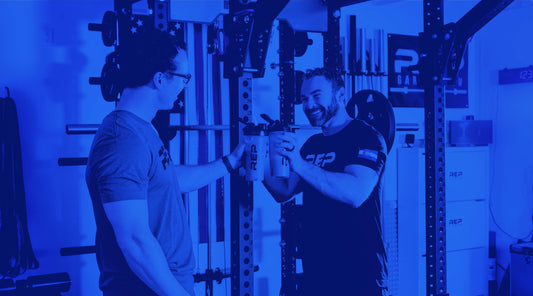
NEWSLETTER SIGNUP
Product launch information, promotions, blogs, and REP news.

